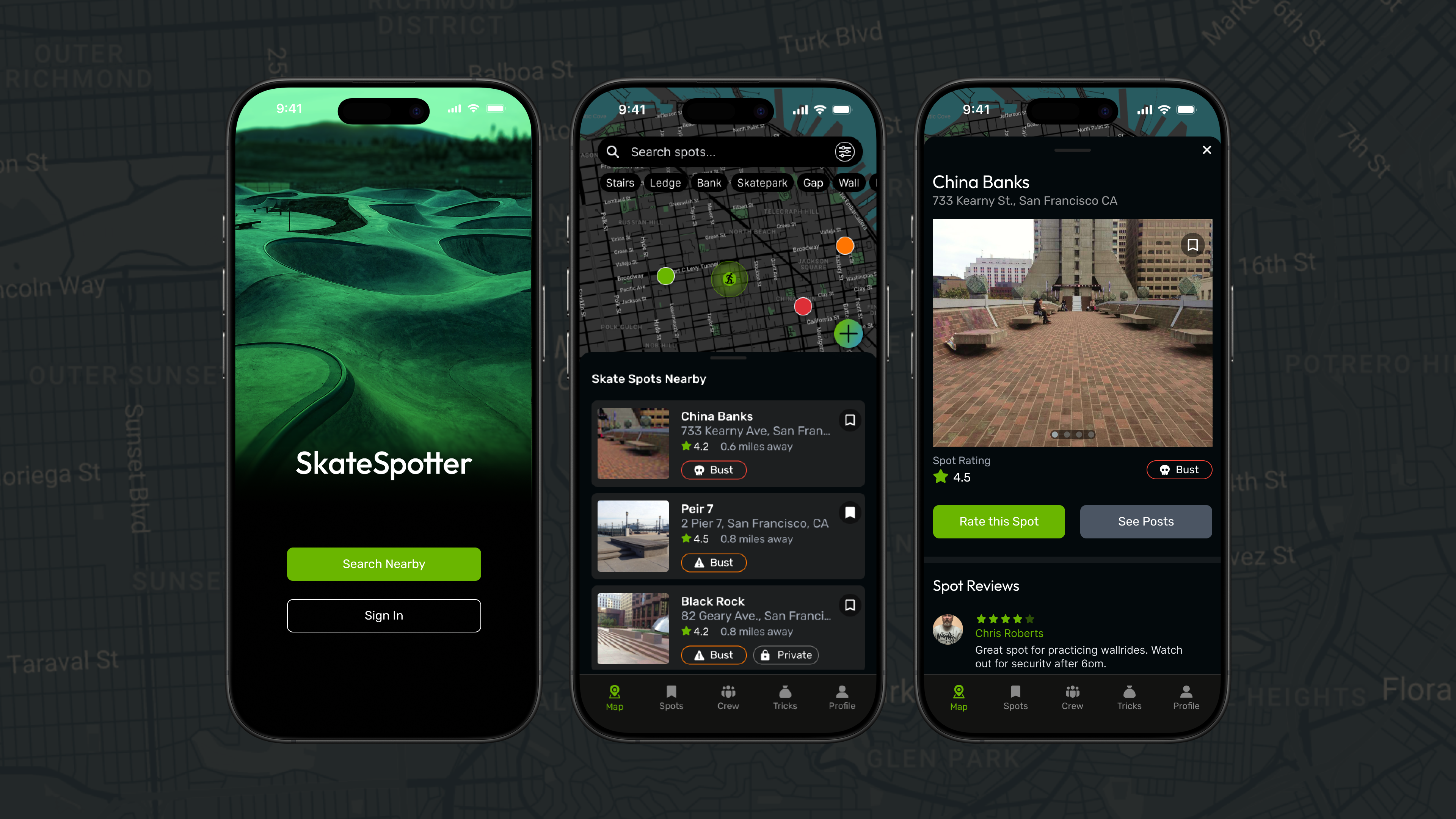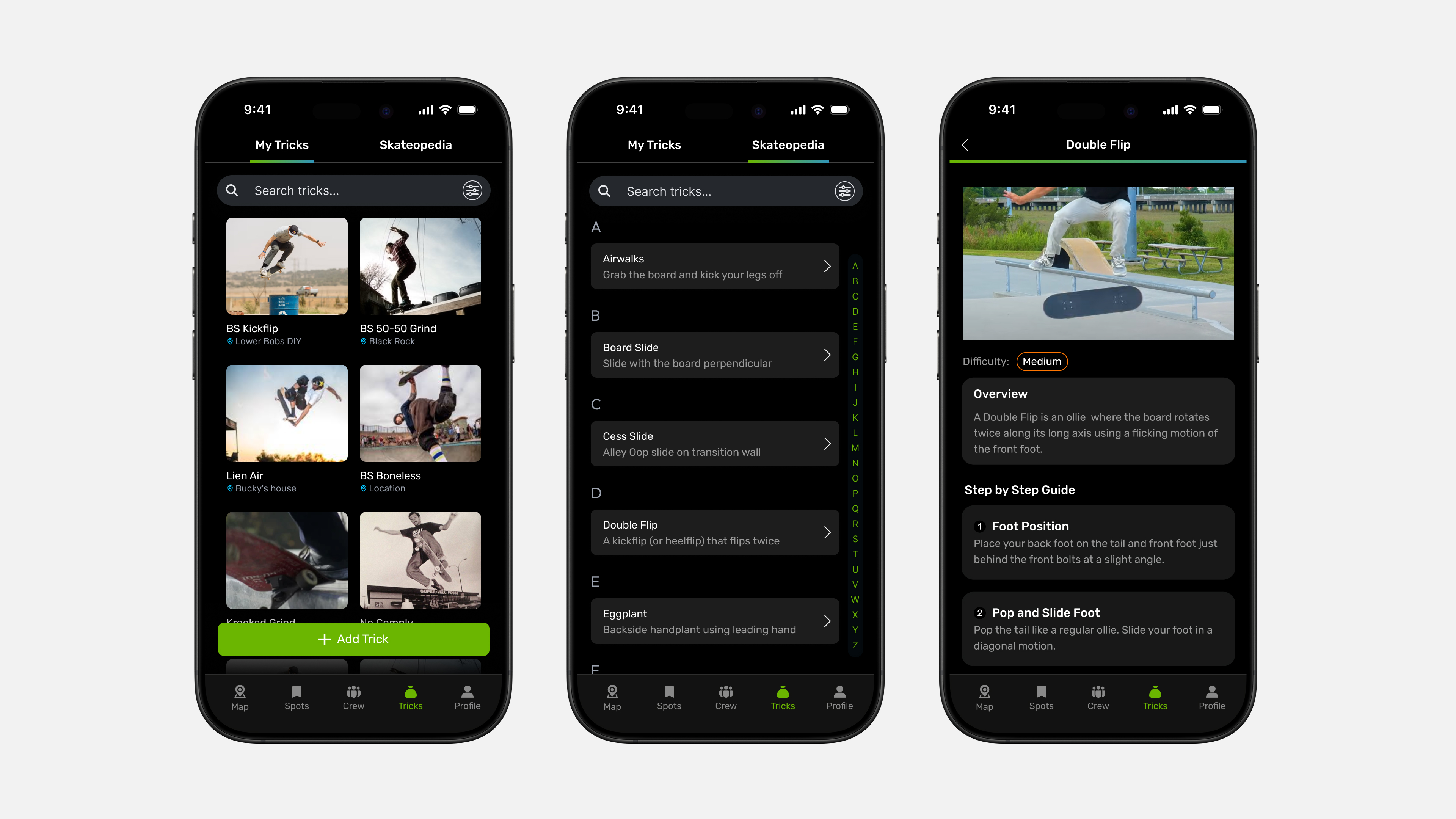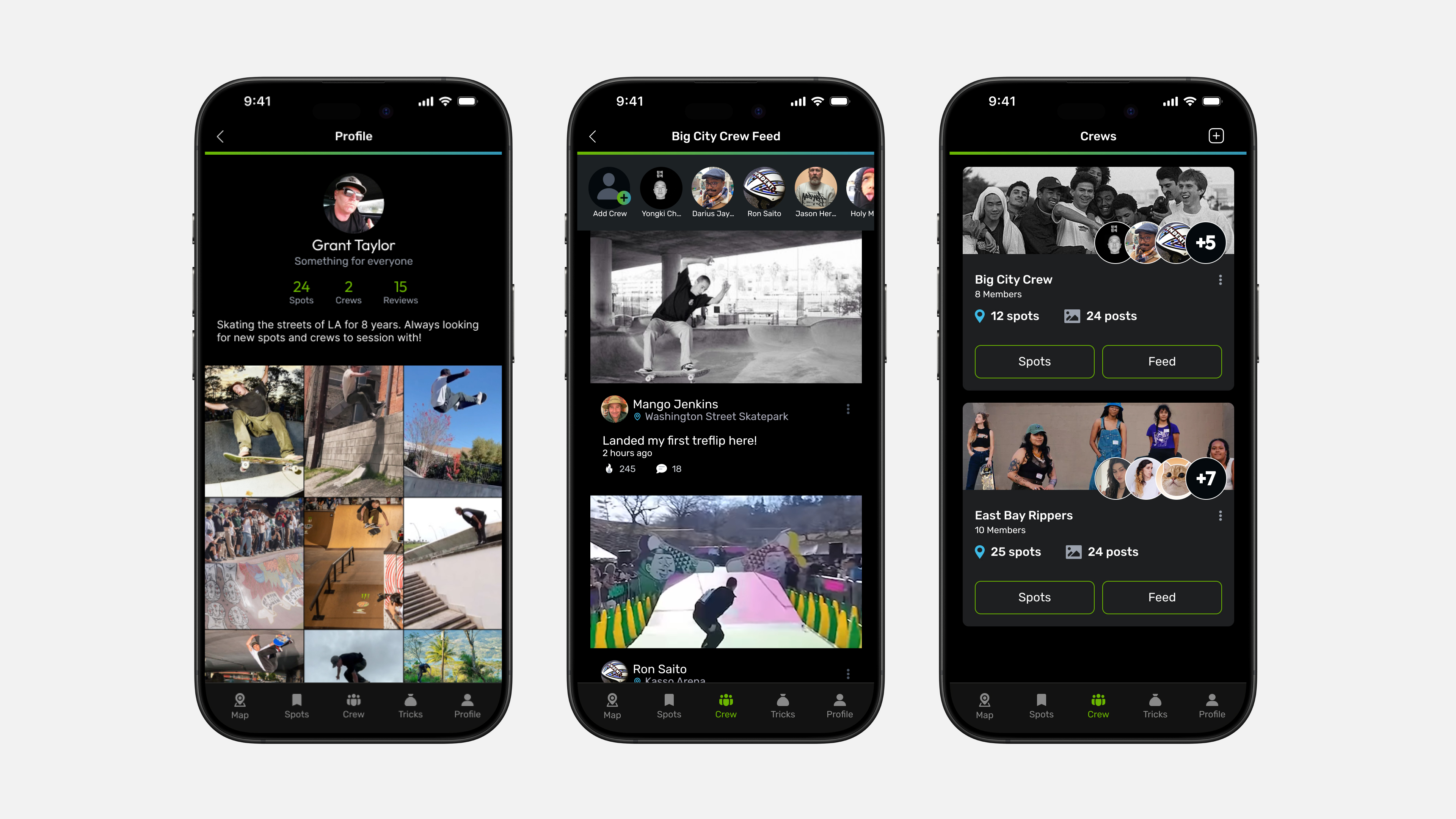Finding Your Spot: Redesigning the Skateboarding Experience
In the skateboarding community, spots are everything. They're where tricks are learned, friendships are formed, and videos that inspire the next generation are created. But for decades, the discovery and sharing of these spots has relied on word-of-mouth, cryptic directions, and jealously guarded secrets.I led the design of Skatespotter, a mobile app that reimagines how skateboarders discover, share, and document their experiences at skate spots around the world.
This case study presents my design process and decisions for the Skatespotter app. All designs and research are my own work created for my portfolio.

The Spot Sharing Paradox
The skateboarding community has always had a complex relationship with spot sharing. On one hand, skaters want to discover new places to practice and film. On the other hand, there's a strong culture of protecting "secret spots" from overcrowding, authority figures, and damage."The best spots are shared through trust, not apps. But when you're traveling or new to an area, you're locked out of that network."
Existing skateboarding apps have struggled to resolve this fundamental tension. They either make all spots public (alienating those who value secrecy) or provide no sharing functionality at all (limiting their utility). The result is a fragmented digital landscape that fails to serve the community's actual needs.
Through extensive market research and competitive analysis, I identified several key problems with existing skateboarding apps:
1. All-or-nothing privacy - Spots are either completely public or completely private, with no middle ground
2. Limited spot information - Basic location data without the context skaters need (bust level, spot type, surface quality)
3. Disconnected experiences - Separate apps for spot finding, trick tracking, and social sharing
4. Poor community features - Limited ability to connect with friends and share experiences
5. Lack of progression tools - No way to track personal growth and trick mastery
These insights led me to a clear design challenge: How might we create a skateboarding app that respects the culture of secrecy while still providing value through spot sharing and community features?
Understanding the skateboarding community and their needs for private spots

Designing the SkateSpotter Experience
After identifying the core problems and understanding our users, I established three primary goals for the SkateSpotter app:1. Create a privacy-centric spot sharing system that respects the culture of secrecy while enabling discovery
2. Build a unified platform that combines spot finding, trick tracking, and social features
3. Design for the full spectrum of skaters from beginners to professionals
These goals guided every design decision throughout the process, ensuring the final product would truly serve the skateboarding community's needs.
The first challenge was creating an information architecture that could support multiple complex features without overwhelming users. I mapped out four primary sections:
1. Map - The central hub for discovering and adding spots
2. Crews - Private groups for sharing spots and content with friends
3. My Tricks - Personal trick tracking and progression
4. Skateopedia - Encyclopedia of skateboarding tricks and techniques
This structure allowed me to separate concerns while maintaining clear relationships between features. The map remains the central experience, with other features enhancing rather than competing with it.
With limited resources and a focus on delivering value quickly, I needed to prioritize features that would form the core experience. I used a value vs. effort matrix to identify the highest-impact features.
The central design challenge was creating a system that allowed for both public and private spot sharing. Through multiple iterations of wireframes, I developed a three-tiered privacy model:
1. Public Spots - Visible to all users
2. Crew Spots - Visible only to members of specific crews
3. Personal Spots - Visible only to the individual user
The Solution: SkateSpotter app
The final SKateSpotter app design centers around a map-first experience that respects the skateboarding community's unique needs. The solution addresses the spot sharing paradox through thoughtful privacy controls, comprehensive spot information, and integrated social features.Discovering Spots: The Map Interface
The primary interface is a map view that displays skateboarding spots with color-coded pins indicating their type and quality. This approach allows skaters to quickly scan their surroundings for potential spots while getting immediate visual feedback about what to expect.
Key features of the map interface include:
- Color-coded pins representing different spot types (ledges, stairs, rails, etc.)
- Quick-view spot cards that appear when tapping a pin
- Proximity indicators showing distance from current location
- Bust level warnings to indicate security risk
- Filter controls to show only specific spot types
Crews: Private Sharing with Friends
The crews feature solves the privacy paradox by allowing skaters to share spots and content with trusted friends without exposing them to the wider public. This maintains the traditional word-of-mouth approach to spot sharing while adding digital convenience.
Trick Tracking and Skateopedia
The trick tracking feature allows skaters to document their progression and maintain a personal record of tricks they've learned. This addresses the need for progression tools that was missing from existing apps. The skateopedia feature provides a comprehensive reference of skateboarding tricks, serving as both a learning resource and a goal-setting tool.
Bag of tricks: Save clips of your tricks and learn new ones with Skateopedia

Profile and crews

Results & Impact
After completing the design of SkateSpotter, I conducted usability testing with a diverse group of skateboarders representing our key user segments. The feedback was overwhelmingly positive, with particular praise for the privacy controls and integrated approach to spot sharing."Finally, an app that gets how spot sharing actually works in skating. I can keep my secret spots secret but still share them with my crew." - Test participant, Core Street Skater
Key positive feedback included:
- Privacy model was intuitive and aligned with real-world behavior
- Spot detail information was comprehensive and relevant
- Crew functionality felt authentic to how skaters actually share information
- Integration of tricks and spots created a cohesive experience
- Visual design resonated with the skateboarding aesthetic
This project reinforced several important design principles while teaching me new lessons specific to designing for tight-knit communities:
Trust is the foundation of community features
The success of the privacy model demonstrated that respecting community norms and building trust should be the foundation of any social feature. By acknowledging the cultural importance of spot secrecy, the design earned users' trust and encouraged participation.
Balance complexity with progressive disclosure
The app needed to support complex features without overwhelming users. The solution was a progressive disclosure approach that presented core functionality upfront while making advanced features accessible through clear navigation paths.
Cultural authenticity matters
The visual design and terminology needed to feel authentic to skateboarding culture without falling into clichés. This required deep understanding of the community and careful attention to visual details that would resonate with users.
The SkateSpotter project successfully addressed the fundamental paradox of spot sharing in skateboarding culture through thoughtful design that respects community values while leveraging modern mobile capabilities.